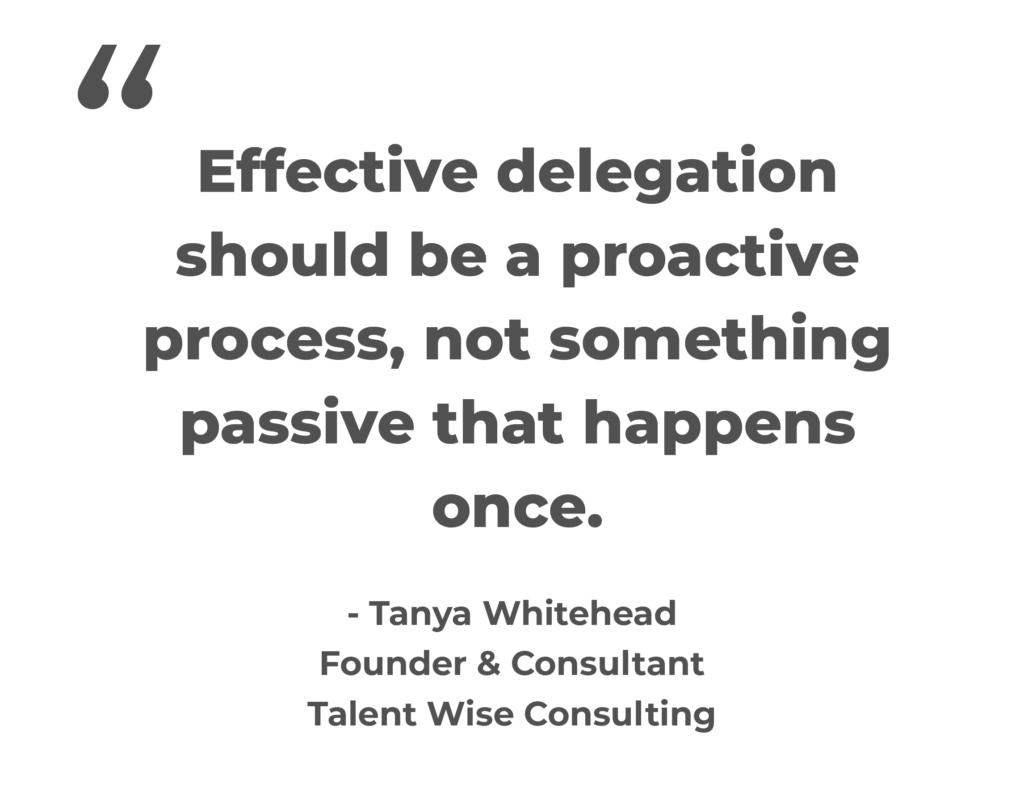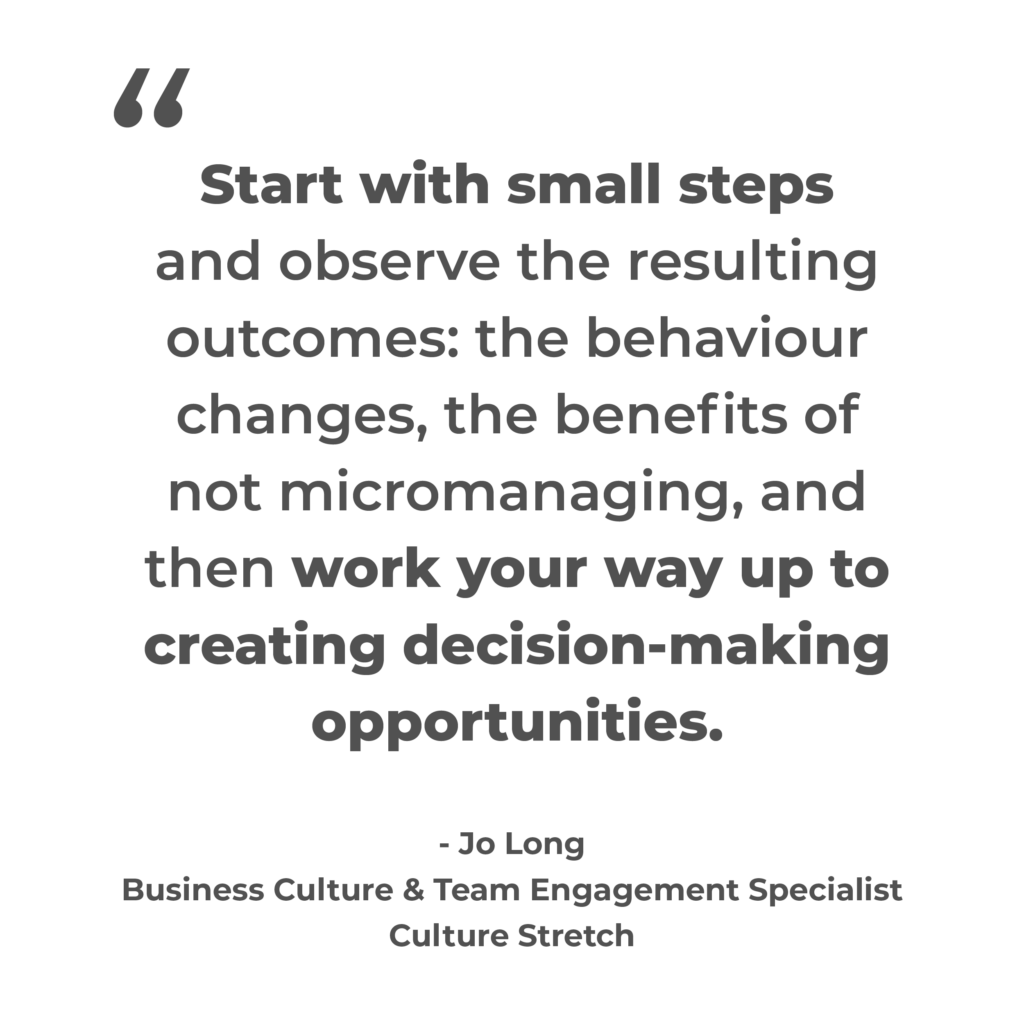Anyone who has led a growing company – or, for that matter a growing team – has experienced it – the continual increase in subjects requiring your attention until one day, your time is no longer your own, and you feel governed by your calendar.
But at a certain point, they will notice that you no longer know everyone’s name, that you’re no longer around for spontaneous chats, and that suddenly, the organisation no longer looks like it used to, and they’ll miss it.
For many, this is the moment when panic sets in. They can’t shake the feeling that they have lost touch, they don’t know what’s going on, and control is slipping away. At this point, leaders generally take one of two paths. They either take a step backward, and attempt to regain the control they lost, or they take a step forward and realise that their notion of “control” must change to grow as a leader.
Regaining control – the wrong way
A leader who tries to regain the control they enjoyed when the organisation was half its current size invariably resorts to some form of micromanagement. They may become fixated on available metrics that measure elements of employee output, such as time and attendance data or activity metrics, such as calls answered or tickets resolved. Often, executives giving into this temptation also start requiring more frequent and detailed reporting from their own cadre of leaders, performing exhaustive reviews of project details and day-to-day operations.
There are a few reasons why this approach won’t work, but they can be summarised with the phrase “That which gets measured, gets done.” When executives focus on employee outputs, they may unwittingly shift emphasis away from more productive activities. For starters, their department heads will spend more of their valuable (and let’s face it, expensive) time on gathering data and crafting reports. Employees will focus on the metrics that are being measured, quickly leading to unintended consequences.
Micro-measurement gone wrong: a mini-case study
Here’s an example I experienced personally at a former employer. We had a large customer service team and implemented a new and more sophisticated system for tracking inbound call activity. Shortly after bringing the new system online, the department head revised the daily call quotas and expectations for call duration after determining the reps could handle more calls each day. The team achieved the new numbers, but we saw an immediate decline in the quality and quantity of case notes produced by the team. Recorded in Salesforce, these details allowed the product and development teams to keep their thumbs on the pulse of customers and considered this information to be of critical importance. But the new quotes didn’t allow the representatives time to log call details, and the company lost insight that slowed bug fixes and all but eliminated some of the most important user data.
Rethinking “control” to foster growth
Instead of panicking, some leaders recognise moments of discomfort as being opportunities to grow. A person with a growth mindset, when confronted with the realisation that the organisation she leads has grown to the point where she no longer knows everyone and everything, understands that as the situation changes, so must her approach. Often this is a combination of delegation and cultivating the information needed to support that approach.
For many, this will feel like “letting go” and it may be uncomfortable. However, we like to simply think of it as changing your grip, versus letting go. The key to successfully delegating responsibility and managing the next stage of growth is to create the structure and framework of objectives and measurement give you a clear view into what’s going on, and allow you to keep tabs on progress.
Laying the groundwork for successful delegation
Before you start intentionally delegating responsibilities to your team, set yourself up for success by creating a framework for setting objectives and measuring progress.

“Effective delegation should be a proactive process, not something passive that happens once,” says Tanya Whitehead of Talentwise Consulting. “Build-in pre-agreed milestones and check-ins, and allow time before the deadline to correct things if they seem to be going off course. Over time you’ll then feel comfortable to ‘let go’ as you know you are able to support and provide guidance (if they need it), and your employees will also learn from the process.”
Here’s a simple framework with just three pillars:
- Align around quarterly goals & ensure they are communicated. Setting and communicating goals every 90 days is a fantastic way to align your leaders. It’s also vitally important when you begin to consciously delegate elements of the business to other people because the goals become the guide rails that keep everyone moving in the right direction.
- Measure outcomes, not the inputs. Measuring outcomes instead of inputs can be incredibly freeing for an organisation and its leaders. In addition to reducing the burden of reporting, and saving yourself from spending time mired in the minutiae, focusing the team on outcomes leads them toward a growth mindset, and helps connect leaders and their teams to the business by enabling them to see how their work contributes to the company’s success.
- Create regular checkpoints on progress against quarterly goals. Creating regular checkpoints to evaluate progress toward the established 90-day goals is the “secret sauce” for this framework. In addition to creating accountability, regular assessment of progress toward goals allows you to both “keep your hand in” while also building your confidence in others. An additional benefit is that you’ll be able to course-correct if necessary, as your delegee learns the ropes.
With these pillars in place, you’re ready for the next step – delegation.
Why delegation is a leadership superpower
Delegation is a foundational skill for leaders. A person who is unable to confidently delegate responsibility to others will only hamstring their capacity to lead.
“The upper limit of what’s possible will increase only with each collaborator you empower to contribute their best work to your shared priorities,” wrote Jesse Sostrin, a leadership development expert, in an article for Harvard Business Review about delegation. “Likewise, your power decreases with every initiative you unnecessarily hold on to.”
Delegation also benefits leaders by providing your team with a degree of autonomy, building trust and confidence, and creating important development opportunities for emerging talent.
Given all this, it should be no surprise that a benchmark study by Gallup of 143 CEOs on the Inc. 500 list found that companies run by executives who effectively delegate authority grew more quickly, generating more revenue and jobs.
In short, don’t dread delegation. Embrace it, and make it your superpower.
Tips for effective delegation
Delegate with intention. It may be tempting to pick one of your reliable performers. Busy people, after all, have a way of getting things done. However, your business may be better served in the long run if you use delegation as a development tool, and select people using the skills they need to develop as your criteria.
“The key to effective delegation is knowing your team’s strengths and key motivators, says Elena Maniatopoulou of Forward Mindsets Consulting. “Utilizing both criteria to assign tasks, delegate or create project teams, is a source for team effectiveness and engagement on behalf of the employees who enjoy autonomy as well as utilizing their skills to contribute to the team’s success.”
Stick to your framework. If you don’t set clear goals, communicate them well, select metrics that focus on outcomes, and commit to regular checkpoints, your efforts at delegation may fail. The framework we suggest above provides clarity, accountability, and alignment – all of which will be crucial to your success, as well as the successes of the people whom you select.
Give your delegees some autonomy. You’re not really delegating if you don’t step away, and give the people to whom you’ve delegated responsibility the autonomy they need to figure out the work and execute it. Not only will you be doing yourself a favor, but you’ll also be accelerating the growth and development of the people you select, as well as their personal satisfaction.
If necessary, give yourself (and others) a break. As you’re starting to delegate – and others are learning to shoulder new responsibilities, it’s important that you prepare for missteps, and learn quickly from failure. According to Deborah Grayson Reigel, in her HBR article, leaders who are good delegators “… tolerate risks and mistakes, and use them as learning opportunities, rather than as proof that they shouldn’t have delegated in the first place.”
Remember, it’s okay to start small.
“Start with small steps, creating some autonomous working teams rather than individuals,” suggests Jo Long of Culture Stretch. “Observe the output of this action, the behaviour changes, the benefits of not micromanaging, and work your way up to steps like creating decision-making opportunities.”
As you embrace delegation, be sure to notice how you benefit. Ideally, you’ll be finding yourself shifting your focus away from day-to-day management and toward growth initiatives. You may also find that the framework is accelerating the completion of work and improving team alignment, helping the business gain momentum. Stick with it, and make delegation your superpower – your business, stakeholders, and employees will all thank you.



